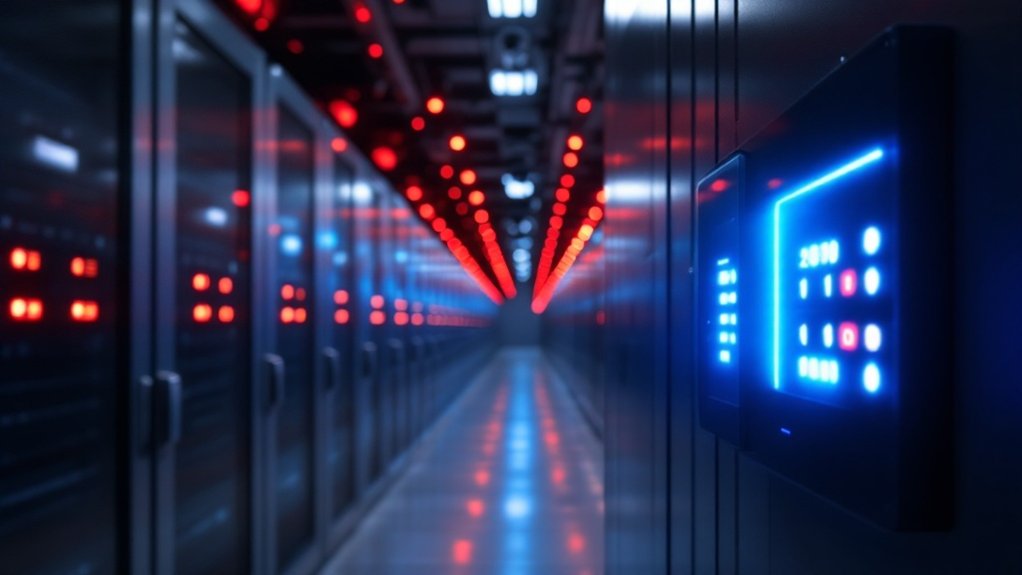As the world becomes ever more data-centric, the need for robust access control systems within data centers is increasingly essential. These systems, operating on principles of identification, authentication, authorization, and accountability, play a crucial role in maintaining data integrity. By employing advanced technologies such as biometrics and AI, they can monitor access patterns and detect potential threats, effectively mitigating risks associated with unauthorized access. The deeper implications of these systems, and their role in safeguarding sensitive information, warrant further exploration.
Understanding the Basics of Data Center Access Control Systems
In today’s digital world, data center access control systems have become the heart of information security. These systems, fundamentally, work as gatekeepers, controlling who has permission to access specific resources within a data center. They operate on the principles of identification, authentication, authorization, and accountability. A user’s identity is first verified using unique credentials. Once authenticated, the system checks if the user is authorized to access the requested resources. All actions are then logged for accountability purposes. The goal is to protect sensitive information from unauthorized access, ensuring its confidentiality, integrity, and availability. These systems can be physical, based on keycards or biometrics, or logical, based on passwords or digital certificates. Understanding this basic functioning is essential for anyone dealing with data security. Additionally, effective access control systems are a critical component in the data management services that protect businesses from data-related issues.
The Importance of Robust Access Control Systems in Data Centers
As the complexity and scale of data centers grow, the need for robust access control systems becomes increasingly critical. These systems are pivotal in maintaining the integrity and security of the vast amounts of data stored, processed, and transferred within these centers. Unauthorized access can lead to catastrophic data breaches, resulting in significant financial losses and reputational damage. Additionally, they can disrupt the essential services that rely on these data centers, such as cloud computing, online transactions, and telecommunication services. Consequently, a well-structured, robust access control system is not merely a precaution, but a necessity. It guarantees that only authorized personnel can access specific areas, providing a critical line of defense against potential security threats. Furthermore, understanding the overview of what a data center does for clients is crucial for ensuring effective implementation of these systems.
Key Components of an Effective Data Center Access Control System
While it may seem intimidating, building an effective data center access control system is achievable when broken down into its key components. To begin with, physical barriers like doors, gates, and locks are essential. These should be strong and durable enough to withstand unauthorized attempts at entry. In addition, identification and authentication devices such as smart cards, biometrics, and passwords help verify the identities of individuals seeking access. Furthermore, an access control panel is needed to process and decide on the access permissions based on the data received from the identification devices. Additionally, an access control server is essential to store and manage all access data and permissions. Finally, regular audits and maintenance checks guarantee the system’s effectiveness and address any potential vulnerabilities before they can be exploited. Moreover, participating in webinars on best practices can provide valuable insights into enhancing your access control strategies.
Advanced Technologies Used in Modern Data Center Access Control Systems
Building on the foundational elements of a data center access control system, modern iterations often incorporate advanced technologies to enhance security. Biometric authentication, using unique physical characteristics such as fingerprints or iris patterns, is increasingly common. This provides an additional layer of security, reducing the risk of unauthorized access. Additionally, AI and machine learning technologies are utilized to identify patterns and predict potential security breaches. For example, they can detect unusual access patterns or attempts that deviate from established norms. IP-based access control systems are another advancement, allowing remote management and real-time monitoring. These systems can be integrated with other security measures for a thorough approach. Through these technologies, data centers achieve robust, state-of-the-art security. Moreover, high-quality data management processes are essential for ensuring that access control systems function effectively and securely.
Case Study: Impact of Access Control Systems on Data Security
In a world increasingly reliant on digital storage, the impact of access control systems on data security cannot be overstated. A case study of a leading fintech organization revealed how the implementation of advanced access control systems greatly increased data security. The company had previously suffered from frequent data breaches, leading to financial losses and damaged reputation. After deploying a modern access control system, there was a marked decrease in unauthorized access attempts, reducing data breaches by 60%. The system’s capability to monitor, log, and alert in real time proved essential in mitigating potential threats. Ultimately, this case study underscores the substantial role access control systems play in safeguarding valuable data in today’s digital age, as effective database management is crucial for enterprise success.
Frequently Asked Questions
What Are the Costs Associated With Implementing Data Center Access Control Systems?
The costs associated with implementing access control systems vary. Factors include the size of the data center, the complexity of the system, installation expenses, and ongoing maintenance. Additionally, potential software licensing fees may contribute to the overall cost.
How Does Data Center Access Control Impact Employee Productivity?
Data center access control can greatly impact employee productivity. Efficient systems streamline access, reduce downtime, and guarantee secure operations. Conversely, complex or faulty systems can cause delays, impeding workflow and reducing overall productivity in the data center.
What Training Is Required for Staff to Effectively Use Access Control Systems?
Training for staff to proficiently use access control systems typically includes understanding the system’s functions, learning access protocols, and emergency response procedures. Regular refresher courses guarantee the maintenance of system integrity and user efficiency.
What Is the Process of Upgrading an Older Access Control System to a Modern One?
The process of upgrading an older access control system to a modern one involves conducting a system audit, identifying necessary improvements, selecting a new system, implementing it, and training staff on the new system’s operation.
Are There Hybrid Access Control Systems That Use Both Traditional and Advanced Technologies?
Yes, hybrid access control systems exist. They seamlessly integrate traditional methods, such as keycards, with advanced technologies like biometrics. This combination guarantees enhanced security while maintaining convenience for authorized personnel.
Conclusion
In summary, data center access control systems are essential in ensuring data security. They operate on principles of identification, authentication, authorization, and accountability, leveraging advanced technologies like biometrics and AI. These systems not only control access but also monitor patterns to detect threats, thereby enhancing security. An effective system mitigates risks associated with unauthorized access, safeguarding data integrity. Therefore, it is imperative for data centers to have robust access control systems in place.






